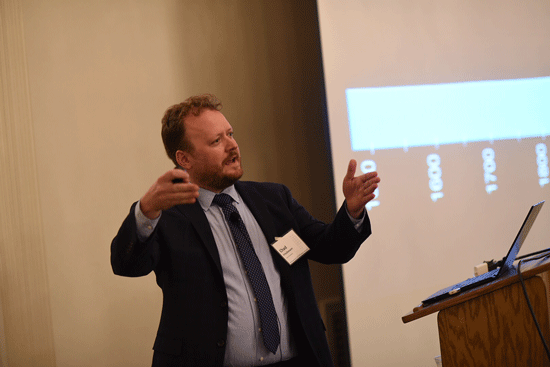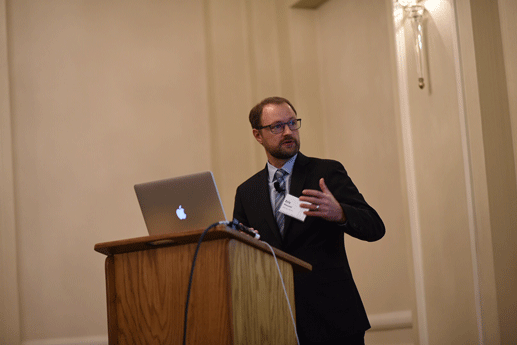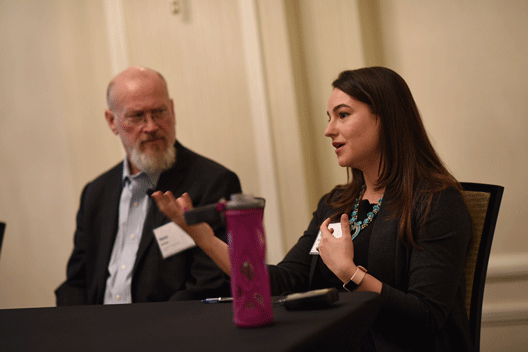By Lakshmi Chandrasekaran
Excuses that exonerate business-as-usual emission scenarios are not a luxury we can afford as climate change heats up the globe, said Chad Frischmann, vice president and research director of Project Drawdown, a climate change mitigation project envisioned by renowned environmentalist Paul Hawken.
But do not despair, since opportunities and optimism can convert all of us into agents of change, said Frischmann, a plenary speaker at Northwestern University’s two-day climate change symposium this November.
Frischmann laid out several economically viable solutions for a packed audience in a talk based on the New York Times bestseller – “Drawdown – The most comprehensive plan ever proposed to reverse global warming.” The book lists 100 solutions based on maximum and immediate impact. As expected, investing in wind turbines and solar farms fall within the top 10 solutions. Some simple, common sense approaches included reducing food waste.
“I can’t believe we already produce enough food to feed everyone on the planet,” said Frischmann, lamenting the fact that nearly a billion people on the planet go hungry while one-third of food raised or prepared is wasted – contributing to 4.4 gigatons of carbon dioxide equivalent or nearly 8 percent of greenhouse gas emissions that are driving climate change. He highlighted these areas where technology could make a significant difference.

But Frischmann also called for social change to combat climate change, with educating girls listed sixth in the Drawdown rankings. Frischmann pointed out that 62 million girls are denied education and, as a result, are unable to influence family planning, global population, and family income. Frischmann emphasized the importance of grassroots action and advocated the need to implement these solutions collectively.
The Institute for Sustainability and Energy at Northwestern (ISEN) and the Department of Earth and Planetary Sciences hosted the symposium that brought together more than 350 attendees from different backgrounds – scientists, business professionals, policymakers and the general public. The goal of this meeting was “empowering impact through dialogue across science, business and policy,” according to the program. Concurrent lectures covered each of these perspectives in a series or programs Nov. 9 and 10, a first for the symposium.

“There is a lot of climate research going on here at Northwestern and cross-pollination is critical, so we invited people from all over the country and abroad,” said Bradley Sageman, professor and chairperson of the Department of Planetary Sciences at Northwestern and an ISEN co-director. “Besides, one of the key mandates for ISEN is outreach, so this conference is open to members of the Evanston community, where the speakers are pitching their presentation to an educated, but a broad audience,” said Sageman. He added that the university’s goal is to achieve zero carbon emissions by 2050.
The urgency for such meetings to target the search for comprehensive and collective action was highlighted by Northwestern engineering faculty member Luisa Marcelino, who studies the complex behavior of coral reefs that are being ravaged by climate change. This is especially relevant with 2016 being the warmest year on record compared to the past 100 years.
“Fifty percent of the coral reef loss has taken place over the past 30 years,” said Marcelino, whose research focuses on developing optical, genetic and phylogenic methods to understand the ecosystem of coral reefs. Marcelino said that the current stressors of coral reefs – fishing practices, nutrient pollution, and coastal development – might serve as a death knell for reefs. One of the possible solutions to save corals, suggested Marcelino, is sustainable fishing.
Since many people depend on fishing for their livelihood, this is a tricky problem to solve, she said, throwing light on one of the socioeconomic aspects of climate change with which climate scientists grapple.

Yet another aspect discussed at this meeting was how far technologies have come in mitigating the effects of global climate change. If we are to uphold the Paris climate accord of limiting global warming to 2 degrees Celsius “carbon capture and storage need to be ramped up hundreds of times,” warned Eric Masanet, Northwestern associate professor in the School of Engineering. Masanet heads the Energy and Resource Systems Analysis Lab that assesses robust emerging technologies to understand the potential for meeting sustainability goals at different scales – regional, national and global. He highlighted the role of the energy sector as key to a sustainable economic growth, advocating a multi-pronged approach to tackle the climate change problem. Radical transformation cannot be achieved via a singular method. “Unprecedented change in technology is required to achieve carbon neutrality by 2060,” predicted Masanet, lamenting that although technology is advancing, the progress is too slow.
Communicating Climate Change
Because any sweeping societal change needs a change in mindset, Northwestern journalism professor Abigail Foerstner moderated a panel on climate communications. It was a call to action for the climate change community to capture hearts and minds of a majority of the population and emphasize the stake that we all have in climate change. This session included environmental activist, Wendy Abrams, who is also the founder of Cool Globes, a public art exhibition aiming to heighten public awareness of climate change solutions. Abrams talked about the disconnect between 55 percent of this country’s population – staunch climate change deniers – and nearly all the climatologists who agree on the increasing toll of global warming. In order to convince and engage climate naysayers, it is critical that the scientists tone down the technical jargon and deliver appropriate messages to audiences that relate to their lives.
And this can be really difficult, pointed out panelist and University of Michigan policy scientist, Kaitlin Raimi. Presenting remarkable research insights about the psyche of the deniers, Raimi said that people tend to overestimate their own knowledge and give credence to their beliefs as opposed to others, creating huge challenges for changing minds about climate change.

Behavioral scientist Hans Breiter showed research on brain activity that supported Raimi’s sentiments and added that to understand and study the emotions of climate change deniers, researchers need to have sound quantitative methods and sufficient data. “This would help to construct a wall map of human behavior and understand what drives people’s beliefs,” said Breiter.
Modeling Climate Change
A necessary pre-requisite to designing solutions to climate change is to understand the factors causing it. Jennifer Kay, an atmospheric and oceanic sciences professor at the University of Colorado at Boulder, uses mathematical models to look at climate change and weather patterns. She starts with the assumption that the ups and downs in climate patterns over the last century are just one of the manifestations of natural climate change and then builds models to test whether this hypothesis is supported. In particular, she investigates whether the driver behind Earth’s climate changes may be tiny changes in Earth’s atmosphere that stimulate a cascade of larger events? In order to understand how small perturbations could lead to a range of variabilities in the weather patterns – and amplify the impact of fossil fuel emissions – Kay and her research group have employed the Community Earth Systems Model – a large ensemble of mathematical equations “that are solved on supercomputers and when taken together – describe processes in the atmosphere, ocean, cryosphere, and land surface and their coupling,” said Kay.
A major advantage of running such supercomputer models is the tremendous predictive power that comes from data-model comparisons of past events and ensemble model approaches. One of the key questions that the modeling work seeks to address is the specific consequence of an increase to 1,000 ppm of carbon dioxide by 2100, which is expected if carbon dioxide emissions continue to increase along the business-as-usual trajectory, said Kay. The results of recent modeling add a new dimension to climate change research since large ensemble models have only become computationally feasible only over the last five years, Kay said. Carbon dioxide levels are currently at slightly more than 400 ppm. At 1,000 ppm the models all predict significant increases in temperatures, but there is significant variance among individual models reflecting the fact that large uncertainty remains in our estimates of future climate change, according to Kay.
Energy-Efficient Development of Nations
An estimated “2.7 billion people lack access to clean cooking and 1.2 billion people lack access to electricity,” said Masanet, underscoring the fact that developed countries are some of the world’s largest energy consumers. As our planet’s population is projected to grow to 11.2 billion people by 2100, compared to 7.5 billion today, number crunching of large magnitudes will take even more precedence to determine if and how we can even sustain such population growth and limit carbon emissions a well. Developing countries such as India and China would be places of unprecedented population growth. Currently, the Asian giants are some of the world’s largest consumers of energy from coal, and energy use is expected to rise.
Expanding on the strategies implemented to counter climate change, Varun Sivaram, Philip D. Reed fellow for Science and Technology at the Council on Foreign Relations at Washington DC, spoke about what it would take for India to invest in solar energy and focused on the role of government’s policy in promoting India’s growth in a sustainable manner. Sivaram warned that the burgeoning population in India would lead to nearly double the number of power surges by 2040, thus making the country a global warming wildcard. And that would mean the nation would need to take drastic steps to clean up greenhouse gas emissions. “The Indian government has set ambitious goals in 2016 to [invest in solar power] such that by 2022, solar energy can provide 10 percent of its electricity demands,” said Sivaram.
Also under the new commitment, India would reduce 2 billion tons of CO2 equivalent emissions (and other heat-trapping gases, such as methane) by 2030. This would completely annul the “Trump effect” said Sivaram since “rolling back President’s Obama’s climate policy, rolling back fuel economy standards would make the United States go up to about 2,000 million [2 billion] metric tonnes of carbon emissions, the same amount India is hoping to reduce from it’s Paris commitment.” As a result, Sivaram advocated that the new narrative should be “India to the rescue rather than saying India is the problem that needs to be solved.” However, Sivaram cautioned that some of the main challenges in meeting these goals are insufficient financing in developing countries. Adopting solar technology is still cost prohibitive worldwide, even if the cost has been declining steadily since 2012.
Ma Jun, director of the Institute of Public and Environmental Affairs (IPE) in Beijing talked about China’s battle against curbing air pollution in the plenary lecture closing the first day of the symposium. Ma Jun is the recipient of several awards for his environmental activism in China, and in 2006 he was named one of TIME magazine’s “World’s 100 Most Influential People”.
“In more recent years, smog has aroused unprecedented [health] concerns,” said Jun, highlighting the IPE launch of a mobile app called the Blue Map that allows the Chinese public to monitor real-time pollution data. Jun mentioned that the goal of the app was to enable the public to act as watchdogs and help curb air and river pollution by factories. In his talk, Jun also highlighted IPE’s creation of the Green Choice Alliance – an alliance of several Chinese NGO organizations that promotes the Chinese real estate green supply chain initiative to bring accountability to environmental performance. This would keep the rampant growth of Chinese real estate, and the resulting environmental pollution, in check, he said.

“Many corporations are also embracing strategies to minimize global warming. There are all kinds of innovations, green technology, efforts and investments going on, but there has to be concomitant support from the highest level of government to address this problem at the appropriate scale,” said Sageman. “I feel like that is the biggest missing piece, especially right now. The current administration is willfully ignorant of the scientific consensus, and their anti-climate change stance is taking the U.S. in the wrong direction,” he lamented.
So what is the immediate take-home? “Go out and vote. When you think about the proportion of Americans who voted in that last election, it’s kind of sad. It was not a great showing. But people were very disillusioned with the choices,” said Sageman, hoping that the next time around voters will have better candidate choices. And he recommended that people educate themselves – “learn about the science, learn about candidate platforms, and get engaged in the political process,” as one the most important steps towards addressing climate change.
Photo at top: A bleached coral reef in the Pacific Ocean resulting from warming ocean temperatures and higher acidity. (NOAA.gov)


